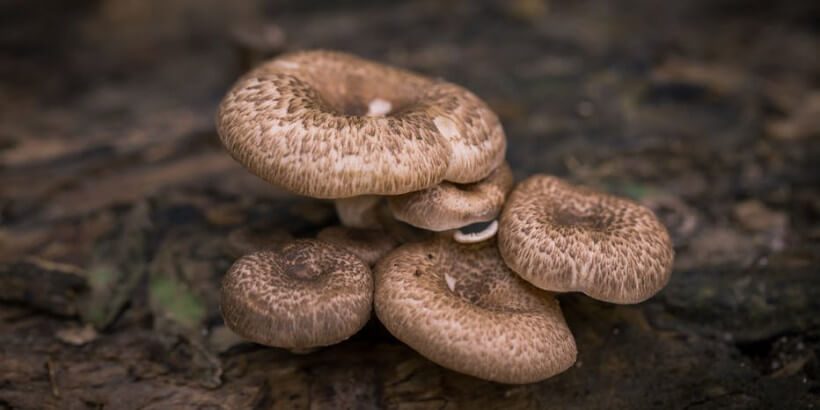Growing Shiitake Mushrooms in a Garage or Yard

Learn how to grow shiitake mushrooms in almost any environment, including your yard and even your garage!
The following is an excerpt from Fresh Food from Small Spaces by R. J. Ruppenthal. It has been adapted for the web.
Some of the most expensive and delicious gourmet mushrooms on the market are shiitakes, which also are credited in Asia with healthful properties such as lowering cholesterol and improving immunity to cancer. They are simple to grow in logs and take about 6 to 18 months to emerge. They can fruit in a wide range of temperatures, from just above freezing to nearly 90 degrees F. To grow shiitake mushrooms on logs, the process is as follows. You will need some hardwood logs (such as oak or beech) about 4 to 6 inches in diameter, a strong drill, shiitake spawn (preferably a strain that is suitable for your growing area; check with the supplier for more info), a hammer, and some hot wax (such as cheese wax or candle wax) that can be melted to seal in the spawn.
Procedure
-
Obtain hardwood logs. Logs that were cut recently are best, but let fresh wood sit at least six weeks before using. Leave the bark on if possible.
-
Drill rings of holes in the log 1 inch deep. Space the holes about 6 inches apart and space the rings about 1½ to 2 inches apart. If possible, alternate the holes in equal spaces and with a zigzag pattern.
-
Into these holes, insert the shiitake spawn. You can order this from suppliers in three forms: inoculated wooden
-
dowels, loose sawdust, or pressurized sawdust pellets. If you get them in dowel form, pound these into the drilled holes with a hammer. Otherwise, insert the sawdust spawn into the holes.
-
Most people like to seal in the spawn with hot wax, which provides a sterilized outer edge and prevents insects or animals from interfering during the incubation period.
-
The mycelium typically will take 6 to 18 months to grow out through the wood. During this time, you can store the logs in a plastic bag in the garage or on the ground outside, covered loosely with a plastic tarp. Make sure to punch a few holes in any plastic covering you use to allow for adequate airflow.
-
Keep the log moist by watering when necessary with nonchlorinated water. Under ideal conditions, the plastic will help maintain humidity, but during dry spells, you should water gently as often as twice per week. Other types of log-raised mushrooms need direct contact with soil (via a partially buried log), but shiitakes do not.
-
The shiitakes will continue to bloom regularly for 4 to 5 years from the same logs. They will appear on their own schedule, but always remember to keep the logs a little moist. One secret to triggering a bloom (after the first bloom cycle) is to soak the log in ice water every two months or so. Mushrooms will appear within a week or so following the ice water treatment. You may want to alternate which log you soak so that they do not all bloom at once.
I believe anyone can be successful with mushroom cultivating at a basic level, but if you want to grow specialty varieties or turn this into a commercial pursuit, then you have a lot more to learn. Like any complex undertaking, you will need to research it well, read some books, network with a local group of mushroom enthusiasts, and learn through your own experimentation.
Recommended Reads
Recent Articles
Want to see your crops thrive this upcoming growing season? The key is in soil fertility and health. Spend time maintaining your soil’s health to guarantee bigger and better crops come harvest time! The following is an excerpt from No-Till Intensive Vegetable Culture by Bryan O’Hara. It has been adapted for the web. What Is Soil Fertility?…
Read MoreIntroducing…your new favorite brunch dish! This whole broccoli frittata is packed with fresh, wildcrafted flavors that are bound to help you start your day off on the right foot. The following is an excerpt from The Forager Chef’s Book of Flora by Alan Bergo. It has been adapted for the web. RECIPE: Whole Broccoli Frittata…
Read MoreMany know the effects of catnip on our feline friends, but few realize that catnip has medicinal effects for humans. From stomach aches to reducing fevers, catnip is a versatile herb with many benefits. The next time you grow this plant for your cat you may end up taking a few cuttings for yourself! The…
Read MoreIt’s time to take control of your seeds and become a plant breeder! Saving your seed allows you to grow and best traditional & regional varieties, and develop more of your own. The following excerpt is from Breed Your Own Vegetable Varieties by Carol Deppe. It has been adapted for the web. Becoming A Plant…
Read MoreWondering where to forage for greens this spring? Look no further than hedges, which serve as natural havens for wild greens and herbs! The following is an excerpt from Hedgelands by Christopher Hart. It has been adapted for the web. Food from Hedges: Salads and Greens Let’s start by looking at all the wild foods…
Read More









